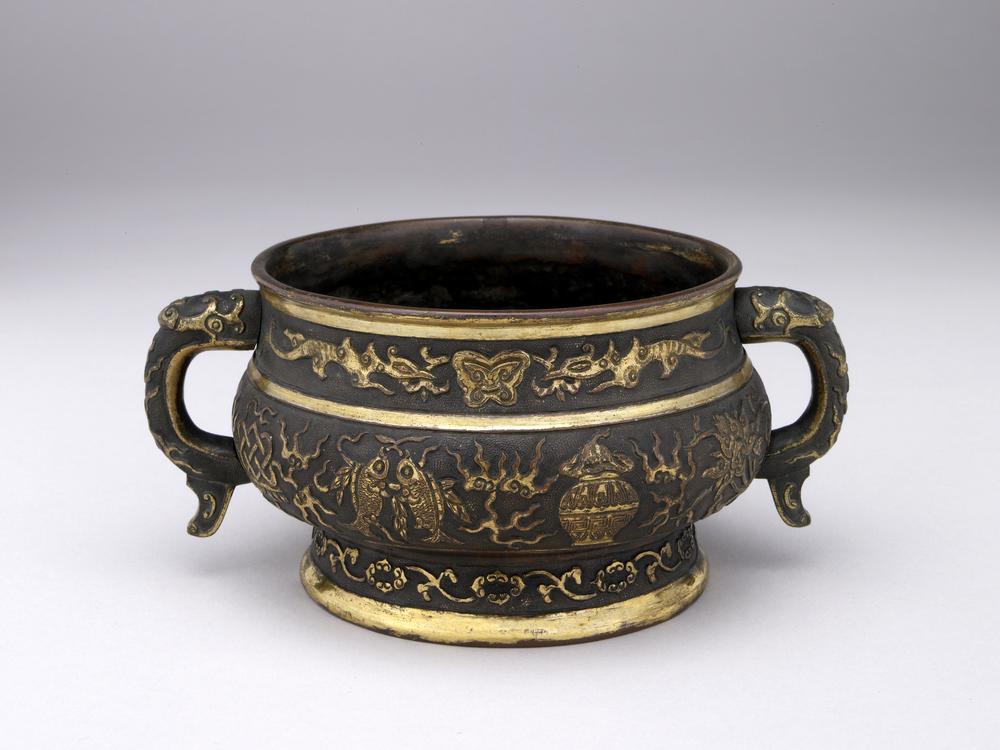Period:Unknown Production date:1500 (ca.)
Materials:paper
Technique:painted
Subjects:landscape equestrian
Dimensions:Height: 232 centimetres (mount) Height: 131 centimetres Width: 69.30 centimetres (mount) Width: 53.30 centimetres
Description:
Painting, hanging scroll. Landscape, in foreground figure riding mule along embankment lined with willow trees; on far bank, beyond water, rocky cliffs in receding layers along edge of water; old man climbing narrow, zigzagging path; gateway and buildings of temple on flank of mountain. Ink and light colours on paper. With paulownia storage box.
IMG
![图片[1]-painting; hanging scroll BM-1966-0725-0.13-China Archive](https://chinaarchive.net/Unknown/Paintings/mid_00035440_001.jpg)
![图片[2]-painting; hanging scroll BM-1966-0725-0.13-China Archive](https://chinaarchive.net/Unknown/Paintings/mid_00236688_001.jpg)
Comments:Smith et al 1990There is little to support the attribution to the Zen priest-painter Kei Shokei (worked mid-fifteenth to early sixteenth centuries), but this Chinese landscape is certainly in an older tradition than that of the Kano school. It retains a lightness, clarity of line and rationality of composition which were inherited from the Southern Song school, especially through the fifteenth-century priest-painter Shubun. The temple is set firmly in the middle ground, and the route to it from the foreground is clearly distinguished. The three-plane organisation inherited from Song painters is completed in the distant mountains in pale blue wash. A comparison with the Kano landscape (1913, 0501, 0157) of about the same period shows very vividly the difference between the two ‘Chinese’ styles. Nevertheless, the relatively limited scale of the landscape displays a Japanese preference.FURTHER READING Shimizu, Yoshiaki, and Wheelwright, Carolyn (eds), ‘Japanese Ink Painting from American Collections: The Muromachi Period’, Princeton, 1976. Hizo Nihon bijutsu taikan Vol 3In the foreground, a human figure is riding a mule along an embankment lined with willow trees. On the far bank, beyond the water, rocky cliffs run in receding layers along the edge of the water, and an old man can been seen heading for the hills along a narrow, zigzagging path. The gateway and buildings of a temple are visible high on the flank of the mountain, drawing the gaze toward more mountains faintly visible in the distance. The composition makes great use of diagonals. The work is traditionally attributed to Shokei, though the picture itself contains neither signature nor seal. However, the treatment of the subject and other aspects of the work are obviously close to the style of that artist.
Materials:paper
Technique:painted
Subjects:landscape equestrian
Dimensions:Height: 232 centimetres (mount) Height: 131 centimetres Width: 69.30 centimetres (mount) Width: 53.30 centimetres
Description:
Painting, hanging scroll. Landscape, in foreground figure riding mule along embankment lined with willow trees; on far bank, beyond water, rocky cliffs in receding layers along edge of water; old man climbing narrow, zigzagging path; gateway and buildings of temple on flank of mountain. Ink and light colours on paper. With paulownia storage box.
IMG
![图片[1]-painting; hanging scroll BM-1966-0725-0.13-China Archive](https://chinaarchive.net/Unknown/Paintings/mid_00035440_001.jpg)
![图片[2]-painting; hanging scroll BM-1966-0725-0.13-China Archive](https://chinaarchive.net/Unknown/Paintings/mid_00236688_001.jpg)
Comments:Smith et al 1990There is little to support the attribution to the Zen priest-painter Kei Shokei (worked mid-fifteenth to early sixteenth centuries), but this Chinese landscape is certainly in an older tradition than that of the Kano school. It retains a lightness, clarity of line and rationality of composition which were inherited from the Southern Song school, especially through the fifteenth-century priest-painter Shubun. The temple is set firmly in the middle ground, and the route to it from the foreground is clearly distinguished. The three-plane organisation inherited from Song painters is completed in the distant mountains in pale blue wash. A comparison with the Kano landscape (1913, 0501, 0157) of about the same period shows very vividly the difference between the two ‘Chinese’ styles. Nevertheless, the relatively limited scale of the landscape displays a Japanese preference.FURTHER READING Shimizu, Yoshiaki, and Wheelwright, Carolyn (eds), ‘Japanese Ink Painting from American Collections: The Muromachi Period’, Princeton, 1976. Hizo Nihon bijutsu taikan Vol 3In the foreground, a human figure is riding a mule along an embankment lined with willow trees. On the far bank, beyond the water, rocky cliffs run in receding layers along the edge of the water, and an old man can been seen heading for the hills along a narrow, zigzagging path. The gateway and buildings of a temple are visible high on the flank of the mountain, drawing the gaze toward more mountains faintly visible in the distance. The composition makes great use of diagonals. The work is traditionally attributed to Shokei, though the picture itself contains neither signature nor seal. However, the treatment of the subject and other aspects of the work are obviously close to the style of that artist.
© Copyright
The copyright of the article belongs to the author, please keep the original link for reprinting.
THE END
![[Qing Dynasty] British female painter—Elizabeth Keith, using woodblock prints to record China from the late Qing Dynasty to the early Republic of China—1915-China Archive](https://chinaarchive.net/wp-content/uploads/2022/11/image-191x300.png)




